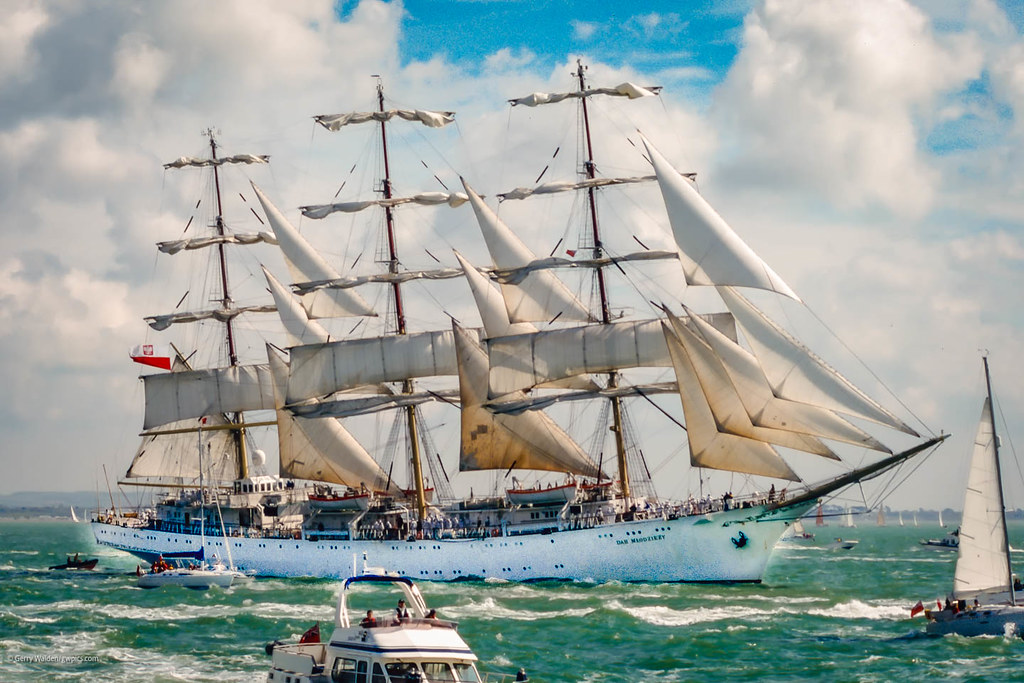#square rig sailing
Text
A while ago Falynn K. asked this question on Twitter:
"So on a tall sailing ship you have the mast, and you have the yards across it--is the yard/spar actually attached to the mast, by like i dunno, a pin or something, or is it strictly roped/lashed to it?"
This is a totally reasonable question! A lot of folks who haven't sailed square riggers might think that the yard stays put, but in fact it needs to move up and down the mast so the sails can be fully set. (Y'know how everyone's always talking about halyards? They literally haul the yard up. You're welcome.)
So to answer the question: yards are held loosely to the mast by a looped line strung with large wooden beads called a parrel. The beads roll up the mast as the yard is raised and lowered. Here's a drawover that hopefully clarifies a little:
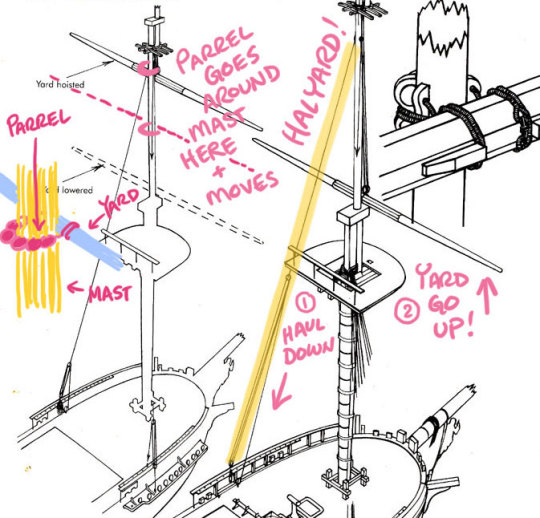
Once you start explaining things about tall ship anatomy it's hard to stop, so there's a bit more context for how the sails work:


(These are pages from my comic A Week at Sea with OHP, which you can read online here or grab as a print minicomic here.)
Hope this is helpful!
#boat stuff#tutorials#ship mechanics#age of sail#art tips#tall ships#square rig sailing#oliver hazard perry#tall ship#sail training
2K notes
·
View notes
Text

Beautiful Square Rigger! Flying her “studding sails”.
A studding sail, or stun'sl, is an extra sail on a square rigged vessel for use in fair weather. It is set outside the square sails, using stun'sl booms which run out along the yards.
More Cow Bell!!
#sailing#sail#age of sail#clipper ship#square rigger#square rigged#tall ships#shipping#sailing life#sailing ship#vieformidable#design#architecture#interior design#art#photography#fashion#foodporn#interiordesign#océan#ocean life
16 notes
·
View notes
Text
Also if my OFMD friends are interested, there's a whole video series on YouTube about how to sail a square-rigged/full-rigged ship.
youtube
This is the first part of three. Part 2, at least, should show up in the sidebar when you watch this one.
#ofmd#sørlandet#full-rigged ship#square-rigged ship#sailing#age of sail#gotta learn the ropes#Youtube
22 notes
·
View notes
Note
top BOATS
ABSOLUTELY BOATS
1. CATAMARAN (DUH)

2. KETCH (TWO MAIN SAILS!!!! AND TWO HEADSAILS!!!!!!)
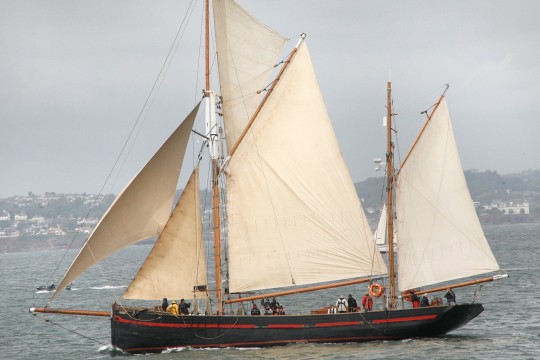
3. SCHOONER (TWO!!!! MASTS!!!!!!! AND TWO!!! HEADSAILS!!!!)
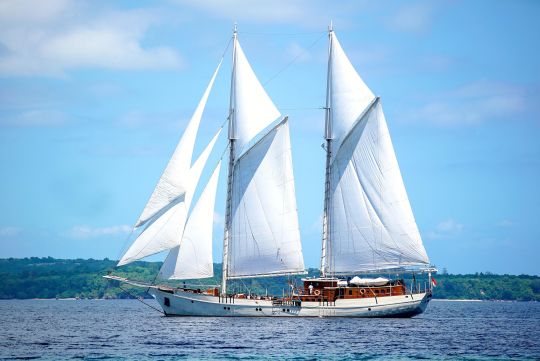
(THIS ONE HAS THREE HEADSAILS!!!!!!!)
4. CUTTER (TWO HEADSAILS [STILL FUN])
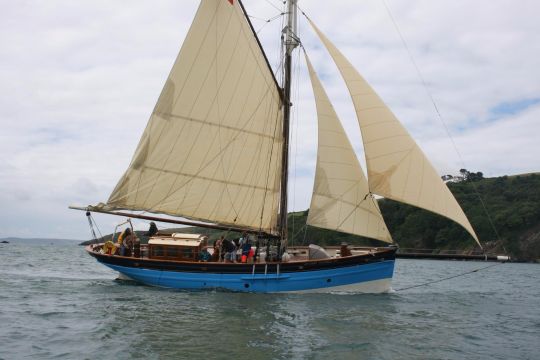
5. SLOOP (ONLY ONE HEADSAIL [JIB OR A GENOA, MAYBE EVEN SPINNAKER] BUT STILL SICK)

#THANK YOU AAAAAAA#several of these are actually gaff rigs which just refers to the physical shape of the sails#gaff sails are the square looking ones#the gaff is actually the pole that shoots up from the mast and allows for a top sail—which are the little triangle sails on top#the sloop on the bottom is smaller than most sloops but i wanted to find a good photo of the one mast and the one headsail#anonymous#redwoods words
25 notes
·
View notes
Photo

41 notes
·
View notes
Text
I was just going to write something silly and little and now I have 10 tabs open about ships and navigation. I've written 2 sentences
#girl help. idk how marine navigation works#how do u know where u ARE#YES i know about astrolabes and sextants and dead reckoning but like. how do u KNOW#like. astrolabes can get u lattitude??? but wh. i mean. i guess thats better than nothing??? but??#what if u lose track of time or speed or heading for an hour?? u just die???#i guess thats what a compass and an astrolabe is for but still?????????#guy who just found out navigation in antiquity was probably hard. clown behavior#i may be. stupid#dont get me STARTED on ship schematics#i get fore and aft sails are easier to manage than square sails especially with a skeleton crew. but like#those are usually used for small boats?? or like a sloop is a good type of rig for what i want but thats so SMALL#i need a ship that is meant to crew like 10ish people min. but CAN be operated. badly. by very very few#and then do small ships even have a below deck??? whadda hell#i dont know. anythinf#this started as 'what side is the anchor on for this type of ship'#the answer is the bow btw. if u were wondering#idk if the anchor ALWAYS goes at the bow bcause thats where it was on the ships i helped out on last summer. but those were TINY tiny#anyhway. i didnt claim to know things#what the fuck is a gaff rig
1 note
·
View note
Video
Dar Młodzieży by Gerry Walden
Via Flickr:
The Polish sail training square rigger Dar Młodzieży (2,384GRT) departing Southampton during the Tall Ships Race.
#England#Fuji RDP#Water#Sea#Yourshotphotographer#Poland#Polish#Ship#square rig#sail training#Tall ship#Craft#Shipping#Solent#Leica R8#Boat#Southampton#Marine#UK#Transport#Analog#Analogue#Film#Hampshire#Hants.#Transportation#United Kingdom#Vessel#flickr
0 notes
Text

U.S. Brig Niagra
A brig has two square rigged masts with an additional gaff sail on the mainmast.
1 note
·
View note
Text
15 pages on random sailboat / ship information for anyone whos willing to read it :3







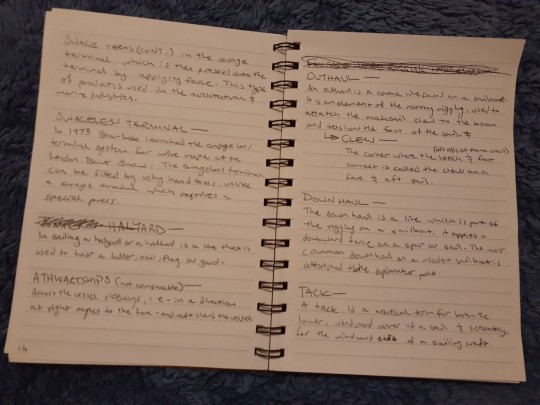
i got bored and ive been wanting to learn more abt ships for a while so boom- heres the first 15 pages, i will definitely do more
if any of it is incorrect please lmk and i will try to correct it!!
#sailboat#boat#ocean#water vessel#idfk what to use for tags lmao-#ship of the line#age of sail#boat rigging#sloop#schooner brig#brig#barkentine#barque#ship#standing rigging#fore-and-aft rigging#square-rigging#running rigging#gaff-rigging#forestays#backstays#shrouds#topping lift#boom#spinnaker#swage terminals#pirate ship#potc#random facts#from yours truly
1 note
·
View note
Text
The whole nine yards
Yards are the timber spars running at right angles to the masts, supporting square sails. (On either side of the mast, the yard is called a yardarm).

HMS Surprise sailing at sea under full sail, by Alex
A fully rigged three masted ship generally had three major sails upon each mast. If all nine sails wer being used, the whole nine yards were working - she was at maximum capacity.
1K notes
·
View notes
Text
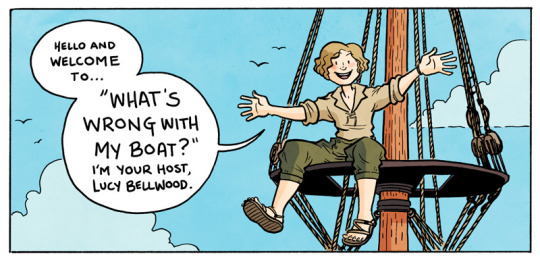
I’ve been meaning to repost this mini-essay I wrote for Global Maritime History back in 2015 for AGES and since today's dash is full of people lamenting the burden of Boat Knowledge this seems like the right time.
ONWARD FOR TALL SHIP ART TIPS!
I often get questions from people who are concerned that their illustrated boats aren’t going to be up to snuff, and the short answer is generally: don’t sweat it. If you’ve drawn a thing that has a hull in the water and sails in the air, you’re off to a great start, and if you consult a few handy reference images, you’re bound to end up with something that looks mostly ship-like.

HOWEVER. There are a couple things that often get lost in translation which—if you pay attention to them—can make the difference between a passable tall ship and a vessel that definitely looks like you know your baggywrinkle from your bunghole. Here’s two tips to get you started.
Flags in the Wind
Generally when we think of a thing that’s going fast, we imagine a flag streaming out in the wind behind it, right? Well, when it comes to square rig sailing, things aren’t always so simple. If the wind is coming up from behind a ship—or from the side—to push it forward, the flag may be flying in a direction you wouldn’t expect! How are the yards angled to catch the wind in the sails? What’s driving the vessel forward? Sailors often look to flags for a quick indicator of wind direction—use that thought process when drawing your ships.

Keep Your Shrouds Tight!
Those rope ladder-looking things sailors are always clambering up? They’re called shrouds, and they also form a large part of the tensioning system that keeps a ship’s masts stable and upright. Stays (lines that don’t move i.e. stay put) are arranged throughout the rig to maintain even aft-to-fore pull on the masts and prevent them from keeling over. Shrouds form the lateral component of that system, so here’s an important fact: they will not be saggy. No saggy shrouds. No saggy stays. In addition to making the mast unstable, it’d be a devil to climb in heavy weather.
Note: the ratlines (the “ladder rungs” of the shroud) can have slack in them—it’s the vertical lines that should be tight.
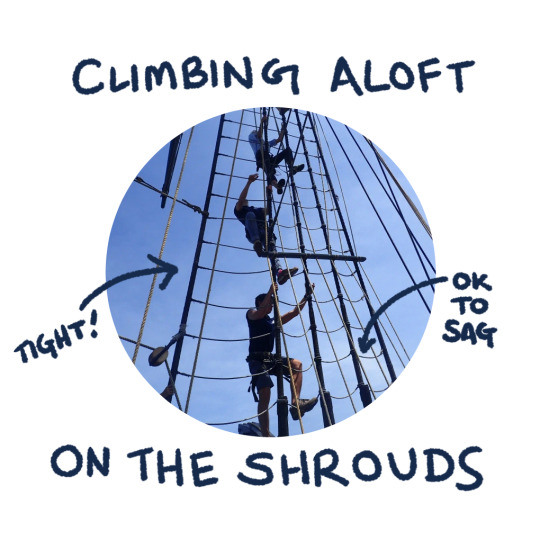
When the crew is “tuning the rig,” they’re putting slack in all the stays and then re-tensioning them to ensure that the whole operation is as stable as possible, so unless you’ve got a bunch of idiots running your fictional vessel, keep ’em tight.
And another thing…
I see a lot of people running their shrouds down to the deck, rather than alongside the vessel. Don’t do that! I mean, okay, sometimes shrouds do attach to chain plates on-deck, but most of your classic Golden Age of Sail vessels will have them running alongside to the channels. Also: they end in deadeyes to help with the tensioning of the line and to keep things stable, so don’t forget your deadeyes!

Honestly, these are the biggest things that I see artists flub when drawing tall ships, so if you can keep them in mind, you’ll be head and shoulders above the rest!
If you’re looking to go more in-depth with your research, I would recommend…
Seeing if you can find a modern replica of the type of ship you’re after and then centering your reference search around the name of that ship. I get far more extensive results when I’m searching for “Privateer Lynx” rather than “1700s topsail schooner.” Don’t discount the many photos tourists will have taken while visiting these ships!
Nose around on model ship-building forums. There is no greater boon to the modern nautical artist than these obsessive craftspeople, who will spend hundreds of hours replicating classic ships in minute detail—often photographing the whole process so you can actually see how the rig of a vessel is put together! God bless ’em.
And that’s all I’ve got! I hope you’ve enjoyed this brief foray into accurate tall ship representation. Fair winds and following seas!
#tall ships#boat stuff#maritime history#tall ship#maritime art#lucy bellwood#art tips#age of sail#personal work
962 notes
·
View notes
Text
hey pirate show friends! in honor of my boat graduation and because I'm procrastinating my work I thought I'd make a post about some super basic sail mechanics/terminology for all your writing-about-ships needs. this just covers the very broad strokes that you'd need to convincingly talk about what's happening on a ship while there's other stuff going on, or to insert some ship-based drama. I'm not an expert and I'm only practically familiar with one tallship that's much later in period than the Revenge. but here are some things I did not know before sail training that I think could be helpful or provide some fun jumping off points for writing! this is super long but I am super procrastinating. hopefully it's helpful to someone. if not, I at least wasted a fun hour thinking about things that aren't my day job.
1. what are the basic types of sails?
for a square-rigged ship like the Revenge, you will have both "square sails" and "fore-and-aft sails." square sails are set perpendicular to the masts and, obviously, are roughly square. they are "bent onto" (meaning connected to) the "yards," which are the horizontal pieces of wood that cross the mast. fore-and-aft sails are set going, well, fore and aft, meaning they follow the line of the ship. these can include staysails (triangular sails bent onto the "stays," or wires that support the masts, and therefore run down the middle of the ship), jibs (also triangular and bent onto stays or wires, but going out along the jibboom and bowsprit, which are the spars that extend forward of the ship's bow), spankers (a large trapezoidal-ish fore-and-aft sail bent onto booms (basically like a fore-and-aft yard) off the mizzen mast, which is towards the stern of the boat, and acts as a wind rudder), and more. some older ships also had spritsails, which were small square sails bent onto yards that hang off the bowsprit. they look very silly in my opinion but to each their own. these aren't all the kinds of sails but they'll cover your basics.
ships can also have any number of sails. full size square-rigged ships can have as few as two or as many as five square sails on each mast. the lowest and largest sail can be called either the mainsail or the course, and are further specified by saying which mast it's on (i.e., the fore course, main course, or mizzen course). going upwards and assuming a five-sail mast, you've next got the lower topsail, upper topsail, topgallant (pronounced t'gallant), and royal. the staysails are named for the mast they connect to. so the most forward might be the "fore topmast staysail," indicating a sail that is connected to the upper part of the foremast.
2. how are sails controlled?
the vast majority of sail control actually comes from the deck and does not require having people aloft, or in the rigging (I'll address the reasons to have people aloft in the next section).
each sail has a number of "lines" (ropes) connected to it at different points that control whether the sail is "set" (fully extended) or "doused" (pulled up towards the yard). more lines are connected to the yards and control how the sail is oriented. the yards can be pulled back and forth, some of them can be pulled up and down, and their angle relative to the horizon can also be adjusted. the square sails on a mast all work together as they are stacked on top of each other and often have interconnected rigging. the lines all come down to the deck and are "belayed" (a figure-eight shaped way of wrapping the rope) around a "pin." the pins may be on a rail that wraps around the ship (the "pinrail"), on a rail that makes a square shape around a mast (a "fiferail"), or on a metal band wrapped around a mast (a "spider rail.") (there are other rails also, especially on the headdeck, which is the most forward, and the quarterdeck, which is the most aft. don't worry about it.)
some things you might do with sails from deck:
set sails (pulling the foot of the sail all the way to the next lowest yard so that it is fully extended and can fill with wind)
douse sails (pulling the foot of the sail up to its yard so that it is no longer catching as much wind. you can leave the sail doused if you might need to set it again, or you can send people aloft to furl it if you do not need it or are in conditions where it is dangerous to have a loose sail)
conduct manuevers, i.e. turn the ship
the three basic manuevers are tacking, wearing, and boxhauling, but all of them are just ways to turn the ship and change course. you can look up the particulars of these manuevers if you're interested, but I think the most important part from a writing perspective is knowing the initial commands. there are a whole series of commands for each of these manuevers but the opening ones you might most need are:
for a tack, the captain or conn (person in charge of issuing manuevering orders), first calls "ready about!" one of the other orders that might be dramatic to have in a writing situation is "helms a'lee," which occurs after ready about and prompts the person at the helm to turn it.
for a wear (the most common and least work-intensive way to turn most large tallships, though it loses you more ground), the order is "prepare to wear ship!"
for a boxhaul (essentially a three-point turn for when you do not have a lot of space to manuever), the order is "stand by to boxhaul!"
you can also stop the ship by "heaving to" (past tense: "hove to"), where you rotate the yards in opposition to each other so that the sails form a right angle with each other, which loses you all of your wind power.
these might change by period or tradition, but are the most common I'm aware of.
the commands for setting and dousing sails are pretty straightforward- you're just going to say "on the [fore/main/mizzen], set/douse your [sail]!" someone lower in the chain of command might also say "hands to the [sail] gear." whatever needs to get done is then accomplished by hauling on, easing (letting go slowly and under control) or casting off the relevant lines.
4. so what do people do aloft?
going up into the rigging is referred to as "laying aloft." you do this by climbing the "shrouds," which are those things you always see people in Boat Media climbing on-- they look like big nets or ladders that extend from the rails of the ship up to the masts. the shrouds may go to "cranelines" (small footropes that allow you to access the middle of a mast between yards, which is often where staysails are stowed), to platforms/crow's nests, or to "footropes," which are strung under each yard. there is also the "headrig," which is a system of footropes and stays that form what looks like a net under and around the jibboom and bowsprit and allow those areas to be accessed. all of these need to be tarred and otherwise repaired, and if a line parts (breaks) a new one needs to be rigged. masts may also need to be tarred or painted and other hardware might need to be repaired, checked, or replaced, such as "blocks" (pulleys that help lines move), shackles, and hooks. you might also need to bend on sails, or even replace entire masts if you're doing heavy repairs in port. people doing these jobs might carry tools or materials tied off in canvas buckets, or ride on a "bosun's chair," which is a wooden swing that can be tied to a gantline and used to lift a person up into the rigging or down over the side of the ship (like stede during the lighthouse fuckery or lucius when he's supposed to clean barnacles).
for non-maintenance related activities, the only things that really need to be done aloft are loosing and furling the sails.
square sails are kept, when idle, rolled and tied to their yards (furled). fore and aft sails are also furled, which depending on the sail may also mean tying it to a mast, or it may mean bundling it down against a stay or spar.
before a ship gets underway, the sails therefore need to be loosed (untied). a captain might not order all sails to be loosed at once when first starting out. if there's heavy winds, you might only need a few sails to get the speed you're going for. in light winds, you might need all of them. the order of loosing on a ship with five square sails per mast is typically: lower topsail, upper topsail, t'gallant, royal, course. but this is ultimately up to the captain's discretion. the courses have a lot of power and you might not need or want that much power when the winds are high.
to loose a sail, sailors are ordered to lay aloft, where they range out along the yard of the sail they're loosing. they stand on the footropes and hold onto a metal rail called the "jackstay." on each side of the yard, there are 3-5 "gaskets" holding the sail tied to the yard. these are loosed as sailors lay out along the yard (the knot is called a butterfly and can be pulled out in one easy motion). then each person stops at their gasket and "gasket coils" it, which coils the gasket up nicely so that it sits right at the yard and doesn't flap around the sail. gasket coils can also be undone easily by flipping one part of the coil over and then just letting the rest fall. the sail can then be set from deck.
you might need to "sea stow" a sail if you have to furl them very hastily, for example if a storm is coming. in this case you'd lay aloft, loose a couple of gasket coils, and spiral them widely inboard (towards the mast) and tie them off. the goal is not to look pretty, just to be fast. the sail will be doused from deck, and the hardest part of this is gathering up the sail the rest of the way so that it can be tied down. you lean your hips against the yard, reach over, and gather up chunks of the sail, tucking them under your belly until you have all of it, and then tie your gaskets. it's hard to do because you are not working together as closely or as carefully in a sea stow situation, and also potentially because the conditions are garbage.
sails ideally are stored in a "harbor furl," particularly, as the name implies, in harbor, where you are not likely to quickly need them loose again, and you have the time to put them away nicely. also, ship people judge each other if these don't look nice. this is a much more synchronized manuever. the sail is doused from deck, then sailors lay aloft in the same way as they did for loosing. here, the people with the hardest jobs are the ones up first, who go out to the farthest points of the yard (the "yardarm"). everyone begins to gather up the sail in the same manner as a sea stow, leaning over the yard and tucking folds of the sail under your stomach. the people at the yardarm are also dealing with the blocks and gear at the lower outside corners ("clews") of the sails. their job is more technically complicated and so they control the rhythm of everyone's gathering. once the sail has been folded and furled nicely with the "sun skin" facing out (protecting the rest of the sail from the elements), the person on the weather (side the wind is coming from) yardarm calls, in rhythm, "roll-ing home," or something similar, which prompts everyone to roll the sail up on top of the yard in unison. then each person wraps their gasket around the sail and yard, ties it off, and heads back down. again, that command might vary by period and tradition.
5. what are some things I could throw in my story for drama?
here are just a few:
a line could part! this is actually not uncommon on buntlines, which are one of the lines that help set and douse sails. when one of these parts and there's any amount of wind, the whole ship is going to know about it very fast because the sail, out of control, will start to "flog." this means it flops around in the wind and makes a very ominous sound (like a huge towel being snapped). to fix it, crew needs to lay aloft immediately and sea stow the sail so the bosun or other skilled crewmember can rig a new buntline.
a note about lines parting: manila lines do not have the "snapback" effect that modern synthetic lines do. this means they part more easily, but also more safely. they also get VERY swollen and spongy when it's wet, because they absorb water, and may even start to unlay (where the strands start to untwist themselves). so they can be also very annoying to handle when wet.
you might have to execute a manuever while people are still aloft! this is not uncommon, particularly for people aloft performing routine maintenance, but not ideal in bad conditions, particularly if people are out on the yards. because manuevers involve the yards being pulled back and forth and therefore rotating on the mast, it can be pretty harrowing to ride one through a manuever (or fun, depending on what kind of person you are). there are also pinch points between the yards and the mast that anyone on the mast or shrouds needs to steer clear of so they don't get crushed by a moving yard. "avast!" is a real command used when there needs to be an immediate all-stop due to a safety issue.
you might have to sea stow in really heavy conditions! if you've seen the episode of black sails where flint sails the Walrus directly into a storm, you know how difficult this is. when a sail is full of wind, it's very hard to pull it up by hand, even when doused. dousing only pulls the sail about 3/4s of the way up to the yard, and a doused sail can still catch wind. in truly heavy winds it can be almost impossible to stow.
in high seas, the ship could roll so badly that people on the yardarms get dunked in the ocean! this has also happened on black sails, I think in that same episode. this has never happened to me but I think if it ever did I would just rather fall off in the ocean than get swung back up again, thanks (<-guy who is afraid of heights). this is not a death sentence though, sailors can and have held on enough that they get swung back up and can safely get down. if conditions are bad enough that this happens and you do lose grip and end up in the ocean, it's probably going to be pretty difficult to impossible to get rescued, at least in the 1700s.
someone inexperienced might belay a line that needs to be cast off in order for a manuever to work, or vice versa. this could be an easy fix or it could cause a very dangerous situation. if you lose control of one of the halyards that lifts the yards, for example, that's potentially tons of uncontrolled load that could fall and break any number of things on its way. or if a line is made fast when it needs to be loosed, you could have yards raised crookedly and/or lines breaking as the strain becomes too much.
rope burn! the lines on a ship are often controlling a lot of load and power. if you allow the rope to slip through your hands instead of moving hand-over-hand, or if you just lose control of it, you can get rope burn that can be pretty severe. it's a wound that almost looks like a burn from fire would, especially while healing.
75 notes
·
View notes
Photo


Here’s a unique 1978 home in Redding, Connecticut. I used to live near Redding, it’s a beautiful town. The home has 2bds. 2ba., and is listed for $950K.

I have never seen a house like this- it’s so unique. The carpet is even done in a colored pattern.

Look at the fireplace. That’s different.

There’s a curvy built-in bench w/a matching table and a walkway. Lots of custom builds in here.

The kitchen is in a sort of curved pavilion. Not sure if it’s a good idea to have spiral stairs between the table and the kitchen.

Kitchen in the round. There appear to be old newspapers and pictures decoupaged on the cabinet doors. I wish they showed more of the feature on the right- was it a former fish tank or just a sculpture?

This is a closet in the main bd., but it also looks like a coat check window.
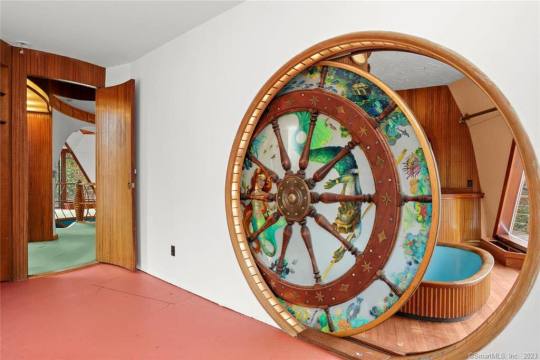
Have you ever seen a bathroom door like that? This is where the house starts getting nautical.

Ahoy! I’m taking a bath.

This is crazy- look at all this artistic work.

How about this shower?

That niche w/the antlers is a little weird.

The 2nd fl. looks like a pirate ship. Notice the crows nest. I see land!

Looks like netting or sail rigging coming down from the ceiling. Climb the ladder thru the small square opening.

Look at where it leads. This is spectacular. And, you can climb all the way up.
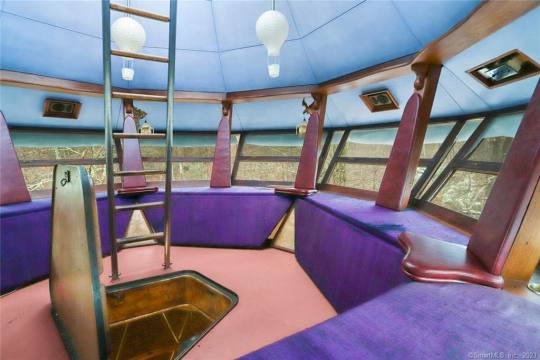
To an observation deck. Is this a cool house or what?


Obsessed w/this house.

And, it’s on 6.52 acres of beautiful land.
https://www.zillow.com/homedetails/11-Indian-Hill-Rd-Redding-CT-06896/177178473_zpid/
242 notes
·
View notes
Text
in which buggy only ever overthinks or refuses to think—no middle sliders—to galdino's great frustration.
part... three? five? six? part three of the post-marineford portion of this story, anyway. (1, 2)
if you have no idea what i'm talking about but would like to read a shanks/buggy story about kissing in disguise and then having to deal with the emotional fallout of doing that, click on this link, that's the tag for the whole thing in chronological order. (plus some complaining about writing, and one inspirational improvised musical number)
if you do know what i'm talking about: the not-date doesn't begin until next time, sorry! buggy needed a few shanks-less scenes first.
Later, Buggy wouldn’t be able to recall anything that happened the rest of the day with meaningful detail. He’d escaped from the mess and found the men eager to ask him more about his days on Roger’s crew—and he probably answered their questions? Watched the crew of the Red Force go through the motions of navigating to an island and coming into dock? Found himself a spot up and out of the way when it came time for the officers to disembark and start arranging for the resupply? However it happened, he ended up in the rigging sometime that afternoon and once again stayed there until dark, staring out to sea and doing his best to think about nothing in particular.
He didn’t see Shanks once. Buggy would have remembered that. His whole head felt filled with cotton, but he had a feeling one glimpse of his specific shade of red would have turned that cotton to so much ash (and possibly set the rest of him on fire while he was at it).
A whole day alone with Shanks.
No need to wonder when that had last happened—that was the day Roger died. Unless you counted Roger’s presence from way up on the execution platform against the descriptor “alone,” which Buggy didn’t. He hadn’t exactly been able to sit down and talk with them that day. Buggy wasn’t even sure, thinking back, if Roger had seen them in the crowd. At the time he’d been convinced Roger was speaking to Shanks directly, conveying his final wishes in his last words, but that was absurd. The square had been absolutely packed with people, and neither of them had been quite tall enough at that age to stand out, even with Shanks wearing that straw-yellow hat of his.
Anyway. A bad day, to say the least. And there weren’t many good ones leading up to it. Crocus, the two of them, and a few others had decided to go east from Water 7, and pooled their money to buy a small boat for the trip. Along the way everyone found an island they liked enough to live on, or at least to visit for an extended time, except for the two of them. It hadn’t seemed to matter much, until they left Crocus at the mountain where they’d first met him and Buggy and Shanks had suddenly been alone. Two boys on a boat that could comfortably hold eight.
Buggy, terrified of what would happen if someone with a grudge against Roger recognized them, had demanded (well, begged, but with a lot of cursing and threats involved) Shanks get them out of the Grand Line and into one of seas big name pirates didn’t bother with. Looking back, Shanks had not been very confident in his ability to get a Sea King to tow their ship across the Calm Belt, but he’d managed it, and they spent a little time sailing the East Blue without a destination in mind. Those days hadn’t been so bad. A little dull, maybe, after being on the Grand Line so long, but Buggy had been happy to be bored.
Then, all too soon, the news had broke, and they sold the boat and raced to Roguetown.
Now those were stressful days. Being so very aware of how little money they had, and how fast it was disappearing into the hands of Roguetown’s restaurateurs and hostel managers… but it wasn’t like they could leave, not when Roger was going to be there in a matter of days, come home to die.
So Buggy had fallen back on old pickpocket habits, and Shanks had offered himself up as bit of a sideshow, doing sword tricks on the street and having people place bets on whether he could beat them in a fight. He’d fight a man one-handed, blindfolded, whatever got passersby to bet more. It made him a little miserable, especially when people got mad they’d lost to a kid and tried to refuse to pay up, but what else could they do? They were fifteen, and they didn’t have a lot of legally marketable skills.
There must have been good days, though. Days they’d spent together without any stress or fear hanging over their heads… days when they had enough money to get a room with real beds, and slept with the certainty that they could afford to keep the room beyond the one night. Days like that must have happened, but Buggy couldn’t think of any now.
Which meant he had no frame of reference for what tomorrow would be like. He was going in totally blind. And that look on Shanks’ face, that undeniably affectionate look… what the hell did that mean?
You’re overthinking this, a part of Buggy that had begun to sound a bit like Galdino said. He looks at you like he likes you because he likes you.
But that was stupid. Who liked Buggy? The former prisoners admired him, sure—because they thought he was powerful. So had the Buggy Pirates, and in East Blue it had even been true. Alvida allied herself with him because of their common interests, and when they turned out to work well together it was simply convenient to continue to do so. People associated with Buggy because he was useful to them, not because he was nice, or likable, or anything like that.
Well. There were some people in this world who would be friendly to you regardless of your utility—but that didn’t make Shanks’ behavior make any more sense! Buggy wasn’t a stranger to him the way he’d been to Ace. Shanks knew him, all his worst behaviors and selfish, greedy impulses. He was nothing like the kind of pirate Shanks was, and even less like the kind of pirate Shanks admired. So what was there about Buggy for Shanks to like?
…maybe it was just a physical thing. Shanks had once kissed a red nose-less Buggy, so he felt safe assuming there was something about his body that attracted Shanks. Enough that Shanks wanted him even with the nose?
Buggy floated his way back to the room he was sharing with Galdino. The mirror was still there, sitting on the bedside table. He used it to inspect himself, head to toe, trying to look at his body with an objective eye.
Galdino came in while he was trying to get a good angle on his back and backside without chop-chopping himself. “There you are,” he said, with a scolding undertone Silvers Rayleigh had often taken with Buggy, as if he was a student falling short of expectations no one had bothered to tell him about. “Dinner’s being served in ten, and I hear it’s either fish the crew caught on our way into port or Sea King loin.”
Buggy made a face. He was so tired of eating Sea King. Every meal in Impel Down had involved the stuff, since it was easy for the guards to get their hands on during the Blue Gorillas’ daily swim. All the briny, fishy stink of the ocean, but with a tough and gamy flesh when left uncured, truly the worst of both worlds. And of course Blue Gorillas were no chefs, so the meat had always been served unseasoned and overcooked.
“Yeah,” Galdino said, “so we’d better get there fast.” He took in Buggy’s posture and frowned. “What are you doing?”
“I—” Buggy thought about trying to explain himself, but as ever Shanks was beyond explanation. But Galdino would be a more objective judge, and it wasn’t like he didn’t already know—he’d been the one to put the idea in Buggy’s head in the first place! Having to ask was so embarrassing, though. Grimacing, Buggy asked, “Am I attractive?”
Galdino stared silently at Buggy for a long moment.
Face hot, Buggy gritted out, “Don’t make me repeat myself.”
“Oh, no, of course not! I just—” Galdino ran a hand over his face, wiping away a thin layer of wax. “Isn’t it kind of late in the honeypot process for you to be worrying about something like that?”
Buggy squinted. “The honeywhat process?”
“The.” Galdino paused. He looked very closely at Buggy, who flushed a little under such scrutiny. Galdino pressed his hands together like someone about to start praying, took a deep breath, and let it out very slowly. “Okay. Let me tell you what I thought was happening, and then you can tell me what you think.”
Hm. Ominous. Buggy nodded agreement.
“Okay.” Galdino gestured between himself and Buggy with his folded hands. “Yesterday, I told you Red-Haired Shanks was interested in you, and warned you to not be so obvious about rejecting him, for all our sakes. This morning, you spent breakfast together, behaving in a way I’ve heard described as friendly, companionable, and ‘weirdly nice, for that guy.’ This culminated in you… asking to spend the day with him tomorrow?” Galdino gave Buggy a wide-eyed, nervous look. “Have I gotten anything wrong so far?”
“No…?”
“Great. So. I take it by your confusion that this was not an attempt to take my advice a little too far in the other direction and get Red-Haired Shanks to do us some kind of favor in exchange for your affections?”
Buggy blinked. “What?!”
“Yes, clearly not,” Galdino muttered to himself. Pinching the bridge of his nose, he said, “But then what are you doing, encouraging him like this?”
“I’m not encouraging—it’s Shanks!” When this did not seem to explain anything to Galdino, Buggy threw his hands out, searching for words. “He’s not—I wouldn’t have to put myself on display like a carnival prize to get something from him, he’d just give it to me! He’d give just about anything to just about anyone, that’s the kind of guy he is.”
“And you… don’t want anything from him,” Galdino concluded, eyes narrowed.
Buggy rolled his eyes. “I mean, I wouldn’t say no to all the treasure hidden away on this ship, but even if Shanks was willing to give it to me I’m pretty sure he’d get outvoted by the rest of his crew. He’s already given us safe passage. He won’t rescind that offer. What else is there?”
“…right.” Galdino stared at Buggy, expression calculating. “Then why are you spending the day with him?”
“Do you have to say it like that?” He made it sound so… suggestive, like two people couldn’t spend time together without it being inherently risqué. (Of course, Buggy had just been wondering whether Shanks was—he viciously shoved that thought down. Not the time!) “Galdino, I asked Shanks to meet privately tomorrow because I want to talk to him about stuff that I don’t need other people overhearing. He’s the one who turned it into a full day thing.”
“And you didn’t argue against it!” Galdino sighed, pinching at the bridge of his nose. “This is what I meant when I said you were encouraging him. You ask for an hour, he offers a day, and you agree to the day? You should have held your ground. If you had more than an hour of things to talk about, you would have asked for more time to begin with. What else is he supposed to think you want to do with that additional time, but…?” Galdino raised his eyebrows suggestively.
Heat slowly rose in Buggy’s cheeks as this sunk in. “We—we could just spend that time… catching up,” he said weakly. “It’s been a long time since we’ve really seen each other. More than twenty years, a lot’s happened.” Including things that it seemed like Shanks might want to happen again. Buggy’s hand went to his mouth unconsciously.
“A lot you want him knowing about? The man—the Emperor—you yelled at right after he stopped a war dead in its tracks, and then saw no problem with bluntly asking him to take all of us on his ship five minutes later? The man you seem to alternate between hissing at and laughing with whenever people see you together?” Galdino rubbed at his temple. “I just don’t understand what—” Galdino froze, staring at Buggy. “Oh.”
Buggy blinked, dropping his hand. “What?”
Galdino turned to stare into the middle distance. “Okay,” he said faintly. “I can work with this.”
“Work with what?” Buggy said, starting to get annoyed.
“Yeah,” Galdino said, nodding to himself with increasing enthusiasm. “This will work. I mean, if anyone else did it I’d call them insane, but in your case—well, how often can you be this certain going in? You know he’s interested, and you’re going to be alone with him for a full day. If you want him, you’ve basically got him.”
Huh. Buggy must have traded devil fruit powers with that Marco guy, because he'd just burst into flames but was somehow still alive. “I—” he croaked out. ”What?”
Galdino’s eyes narrowed. “…you do want him, right?”
Nothing but static between his ears, Buggy threw open the door to their room. “Hey, didn’t you say dinner was happening soon? We should go! I am so sick of Sea King, you have no idea—”
“Buggy!”
Buggy jogged down the stairs, wondering aloud how Lucky Roux might have prepared the fish his crew had caught—braised? roasted? So many delicious possibilities!
Sticking his head out the door after Buggy, Galdino called out, “Do you even know what you want?” He let out an exasperated sound when Buggy picked up his pace and started waxing rhapsodic about fried fish still hot from the oil.
It would’ve been nice if Buggy could forget that conversation along with the rest of the day, but no luck. Long after Galdino fell asleep, an anticipatory pair of wax plugs in his ears, Buggy laid awake with those words running through his head. Lined up next to the other things he’d said about Shanks, it sounded pretty damning.
They all say the two of you got up close and personal, and Red-Hair’s been red-faced ever since.
Fact is he’s an Emperor. One who’s taken an interest in you.
If you want him, you’ve basically got him.
…you do want him, right?
Buggy muffled a frustrated groan into his pillow.
At least dinner had been delicious: perfectly fried whitefish in a delicate batter that tore at the slightest hint of pressure, letting steaming-hot juices burst free and burn your tongue, served with fried potatoes and vinegar and a creamy sour pickle sauce. Messy, but well worth getting to the kitchen early for.
That showing up early meant he didn’t run into any of the still-busy senior officers of the Red Force… well, that was just good luck.
“‘Getting ahead in life requires either good luck or good planning, and Buggy, you’re not much of a planner.’” Buggy grumbled to himself. “Shows what you know, Mr. Rayleigh… my luck’s not much to speak of either, yet here I am, getting ahead.” And who knew? Maybe tomorrow, he’d get—
Face burning, Buggy refused to complete the thought.
He also refused to consider the question that thought brought to mind: was that all he wanted from Shanks?
Or its corollary: was that all Shanks wanted from him?
#notfic#the near miss fics#one piece#shuggy#buggy#i should probably also tag for mr. 3 but. not gonna. he deserves to be a more central focus in his tag.
51 notes
·
View notes
Note
This might be an absurd question to ask, but what type of ships were the Erebus and the Terror? I've recently had an interest in Polar Expeditions (particularly the ships themselves). I would look it up myself but I have a phobia of dead/decaying bodies and mummified people, and I am almost certain looking up "Franklin Expedition" would show images of the dead.
Thank you.
Hey there, friend! That's not an absurd question at all, and if you're at all uncomfortable with images of dead people, not searching "Franklin Expedition" online is probably a very wise decision.
HMS Terror and HMS Erebus were both bomb vessels, which in the 19th century Royal Navy meant full-rigged ships (three masts, square-rigged sail plan) made with extremely strong hulls to withstand the recoil of their weaponry—mortars that fired explosive shells, rather than cannons that fired more traditional shot. This type of weaponry was usually used for the bombardment of land-based targets, as in the famous bombardment of Fort McHenry during the War of 1812, in which Terror participated.
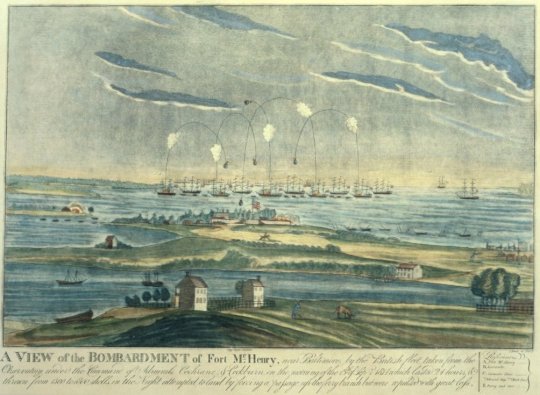
A View Of The Bombardment of Fort McHenry, © Public Domain.
The reinforced hulls that were made to withstand mortar recoil were also able to withstand (at least, to a certain degree) the immense pressure that would come with being icebound, so during the late 18th and early 19th century, bomb vessels were the preferred ships for polar exploration.
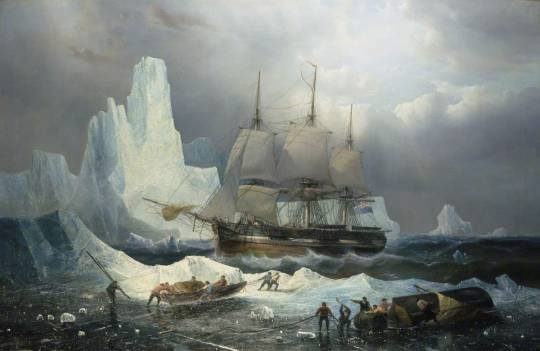
Erebus In The Ice, © François-Etienne Musin
Later polar expeditions tended to use whaling ships, like the Nimrod and the Terra Nova, or purpose-built polar exploration vessels, like the Endurance and the Fram. I hope this helps!
#ask#polar exploration#hms terror#hms erebus#franklin expedition#maritime history#royal navy#naval history#war of 1812#bomb vessels#nautical#19th century#the terror amc#definitelynothanna
52 notes
·
View notes
Text
Full-rigged ship

This was mostly just a study on how the sails on an airship like this would be positioned.
More traditional square-rigs like this are only one of many sail & rigging types used by ships that cross the mare nubium, though it is the most popular one in the core-regions of the Empire.
Fun fact, the hull itself in this is actually based off of the Black Pearl from the Pirates movies.
#shardreach#worldbuilding#ttrpg art#fantasy art#sailpunk#age of sail#concept art#steampunk#airship#sailing ship#sailing#pirates#pirates of the caribbean
45 notes
·
View notes
